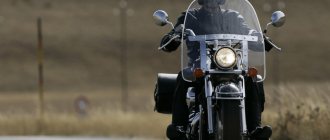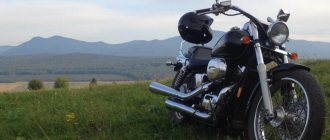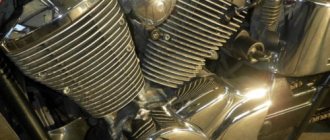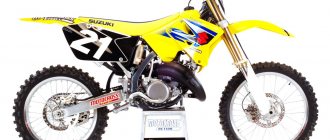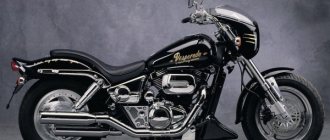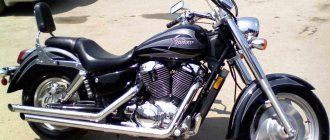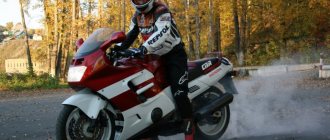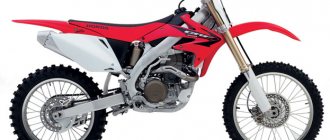| Honda NV750 Custom (1983-1985) | Honda NV750 Shadow (1986) | Honda VT750C Shadow ACE (1997-2001) |
| Honda VT750CD Shadow Deluxe (1998-2003) | Honda VT750DC Shadow Spirit (Black Widow, Slasher) (2000-2007) | Honda VT750C Shadow Aero (2004+) |
| Honda VT750C2 Shadow Spirit (2007-2015) | Honda VT750C2B Phantom (Black Spirit) (2009+) | Honda VT750S / VT750RS Shadow RS (2010-2013) |
Honda Shadow 750 Cruiser Series
begins its history in 1983 and the appearance of the
Honda NV750 Custom
, which was available in the markets of North America and Japan.
In 1986, the motorcycle changed its name to Shadow 750
, being updated technically and visually. The model of that time was quite heavily boosted (which is typical for all Japanese cruisers of those years), producing up to 66 hp. power. These versions are present at Japanese auctions, but due to their age, there are not many of them.
In 1997, the first version with the name Honda VT750 Shadow
in the American Classic Edition (ACE) modification, which began the rapid growth of the model’s popularity. The modification featured classic American features with deep fenders, wide spoked wheels and chain drive. At the same time, an internal Japanese modification was released - the Honda Shadow 400.
In 2000, the Shadow 750 line was replenished with a new modification - Honda VT750DC Shadow Spirit
.
In Japan it was sold under the name Slasher
, and in Europe -
Black Widow
. The model featured short fenders, a thin 19′ front wheel and a smaller fuel tank (13 liters instead of 14 liters in the ACE). Otherwise, the motorcycle was equipped with the same engine, chain drive and two carburetors.
In 2003, the Honda VT750C Shadow ACE modification finally left the market, giving way to the new Honda VT750C Aero
. The new model received many technical changes regarding ergonomics, overall dimensions, front suspension, engine, intake system (using one carburetor instead of two) and drive (instead of a chain, the model received a cardan and changed gearbox ratios).
In 2007, the Honda VT750DC Shadow Spirit (Slasher, Black Widow) modification left the market, giving way to the new Honda VT750C2 Shadow Spirit
. The model visually resembles the previous modification, but is equipped with a 21′ front wheel, electronic fuel injection (since 2008, 1 carburetor in 2007), cardan drive and a 14-liter tank. The Aero modification gets an injector.
In 2009, another modification appeared - Honda VT750C2B Phantom
.
In some countries it was sold under the name Black Spirit
. Despite the similarity of the name with the Honda VT750C2 Shadow Spirit, the Phantom modification is not related to it, but is a version of the Aero in black, straight handlebars and short fenders. The Aero modification includes versions with ABS.
In 2010, another modification was introduced - Honda VT750RS Shadow
.
In the Japanese market it was sold as the Honda VT750S
. Visually reminiscent of the classic Honda VRX400. The Shadow 750 differs from the entire line in its shortened wheelbase, increased seat height, increased ground clearance, practically the lowest curb weight (second only to the NV750 Custom), a 10-liter fuel tank and a chain drive.
In 2013, the RS modification leaves the market, and the Honda VT750C2 Shadow Spirit receives a version with ABS (designated VT750C2S). 2015 was the last year of production of the Honda VT750C2 Shadow Spirit modification.
Currently, only the Aero and Phantom versions are present in the production line.
The main competitors of the Honda Shadow 750 in the class:
- Kawasaki VN 750 Vulcan / Kawasaki VN 800 / Kawasaki VN 900
- Suzuki Boulevard C50 / Suzuki VZ 800 Marauder (Desperado) / Suzuki VS750 Intruder
- Yamaha XV 750 Virago / Yamaha XVS 650 Drag Star
Brief history of the model
- 1983 - start of production and sales of the Honda NV750 Custom model.
Model
: Honda NV750 Custom (Japan, North America).
Frame number
: RC14-XXXXXXXX.
- 1986 - The Honda NV750 Custom model is updated and changes its name to the Honda Shadow 750.
Model
: Honda NV750 Shadow (Japan).
Frame number
: RC25-XXXXXXX.
- 1997 - appearance of the Honda VT750C Shadow ACE modification
Model
: Honda Shadow 750 ACE (Japan, Europe, North America).
Factory designation
: VT750CV, VT750C2V.
- 1998 - no significant changes. The appearance of the Honda Shadow 750 ACE Deluxe version.
Model
: Honda Shadow 750 ACE;
Honda Shadow 750 Deluxe (Japan, Europe, North America). Factory designation
: VT750CW, VT750C2W; VT750CD.
- 1999 - no significant changes.
Model
: Honda Shadow 750 ACE;
Honda Shadow 750 Deluxe (Japan, Europe, North America). Factory designation
: VT750CX, VT750C2X; VT750CD.
- 2000 - the Honda Shadow 750 ACE modification receives different suspension settings, a seat height lowered by 2 cm and wiring for installing an immobilizer (purchased separately). Japanese versions receive an exhaust afterburning system that meets new internal toxicity standards. The appearance of the Slasher modification.
Model
: Honda Shadow 750 ACE;
Honda Shadow 750 Deluxe; Honda Shadow 750 Slasher (Japan, Europe, North America). Frame
: RC44-XXXXXXX (ACE, Deluxe);
RC48-XXXXXXX (Slasher) Factory designation
: VT750CY, VT750C2Y, VT750C3Y; VT750CD.
- 2001 - Spirit (Black Widow) version available in foreign markets.
Model
: Honda Shadow 750 ACE;
Honda Shadow 750 Deluxe; Honda Shadow 750 Slasher (Black Widow, Spirit) (Japan, Europe, North America). Frame
: RC48-XXXXXXX (Black Widow, Slasher), RC44- (Spirit).
Factory designation
: VT750C21, VT750C31, VT750C1; VT750CD, VT750CD2, VT750CD31; VT750DC1, VT750DC.
- 2002 - no significant changes. The ACE version is no longer offered (ACE Deluxe is still available).
Model
: Honda Shadow 750 Deluxe;
Honda Shadow 750 Slasher (Black Widow, Spirit) (Japan, Europe, North America). Factory designation
: VT750CDA, VT750CDB, VT750CDC, VT750CDD; VT750DC, VT750DC2.
- 2003 - no significant changes.
Model
: Honda Shadow 750 Deluxe;
Honda Shadow 750 Slasher (Spirit) (Japan, North America). Factory designation
: VT750CDA, VT750CDB, VT750CDC, VT750CDD; VT750DCA, VT750DCB.
- 2004 - The ACE Deluxe modification is no longer offered, replaced by the Aero version.
Model
: Honda Shadow 750;
Honda Shadow 750 Aero (Japan, Europe, Australia, North America). Frame
: RC50-XXXXXXX.
Factory designation
: VT750C, VT750C4.
- 2005 - no significant changes.
Model
: Honda Shadow 750, Honda Shadow 750 Aero;
Honda Shadow 750 Spirit (Japan, Europe, Australia, North America). Factory designation
: VT750C, VT750C5; VT750DCA, VT750DCB.
- 2006 - Honda Shadow 750 series models receive a HISS immobilizer.
Model
: Honda Shadow 750, Honda Shadow 750 Aero;
Honda Shadow 750 Spirit (Japan, Europe, Australia, North America). Factory designation
: VT750C, VT750C6; VT750DCA, VT750DCB.
- 2007 - appearance of the Honda VT750C2 Shadow Spirit modification.
Model
: Honda Shadow 750, Honda Shadow 750 Aero;
Honda Shadow 750 Spirit (Japan, Europe, Australia, North America). Factory designation
: VT750C, VT750C7; VT750C2, VT750C2F, VT750DCA, VT750DCB.
- 2008 - The Honda VT750DC Shadow Spirit modification is no longer offered. The new modification of the Honda VT750C2 Shadow Spirit receives an injector. The Aero modification receives an injector, a catalyst, dual independent exhaust (instead of 2-in-1) and a front brake disc located on the right side (instead of the left, to improve weight distribution).
Model
: Honda Shadow 750, Honda Shadow 750 Aero;
Honda Shadow 750 Spirit (Japan, Europe, Australia, North America). Factory designation
: VT750C, VT750CA8, VT750C8; VT750C28, VT750C2F.
- 2009 - appearance of the Honda VT750C2B Phantom modification. The Aero version gets a modification with ABS (with rear disc brake).
Model
: Honda Shadow 750, Honda Shadow 750 Aero;
Honda Shadow 750 Spirit, Honda Shadow 750 Phantom (Japan, Europe, Australia, North America). Frame
: RC53-XXXXXXX (Phantom);
RC56- (Aero ABS). Factory designation
: VT750C9, VT750CA9, VT750CA, VT750C; VT750C29, VT750C2F9, VT750C2, VT750C2F.
- 2010 - appearance of the Honda VT750RS Shadow RS modification. In Japan - VT750S.
Model
: Honda Shadow 750 Phantom (Spirit Black);
Honda Shadow 750 RS (Japan, Europe, Australia, North America). Frame
: RC58-XXXXXXX (RS).
Factory designation
: VT750C2B; VT750RS, VT750S (Japan).
- 2011 - no significant changes.
Model
: Honda Shadow 750, Honda Shadow 750 Aero;
Honda Shadow 750 Phantom (Spirit Black); Honda Shadow 750 RS (Japan, Europe, Australia, North America). Factory designation
: VT750C; VT750C2B; VT750RS, VT750S (Japan).
- 2012 - no significant changes.
Model
: Honda Shadow 750 Aero;
Honda Shadow 750 Spirit; Honda Shadow 750 Phantom (Spirit Black); Honda Shadow 750 RS (Japan, Europe, Australia, North America). Factory designation
: VT750C, VT750CA; VT750C2, VT750C2F; VT750C2B; VT750RS.
- 2013 - no significant changes. The Spirit version receives a modification with ABS (VT750C2S).
Model
: Honda Shadow 750 Aero;
Honda Shadow 750 Spirit; Honda Shadow 750 Phantom (Spirit Black); Honda Shadow 750 RS (Japan, Europe, Australia, North America). Factory designation
: VT750C, VT750CA, VT750CS; VT750C2, VT750C2F, VT750C2S (ABS); VT750C2B; VT750RS.
- 2014 - RS modification is no longer offered.
Model
: Honda Shadow 750 Aero;
Honda Shadow 750 Spirit; Honda Shadow 750 Phantom (Spirit Black) (Japan, Europe, Australia, North America). Factory designation
: VT750C, VT750CA, VT750CS; VT750C2, VT750C2F, VT750C2S (ABS); VT750C2B.
- 2015 - no significant changes.
Model
: Honda Shadow 750 Aero;
Honda Shadow 750 Spirit; Honda Shadow 750 Phantom (Spirit Black) (Japan, Europe, Australia, North America). Factory designation
: VT750CF + VT750CSF (C-ABS); VT750C2BF
- 2016 - no significant changes.
Model
: Honda Shadow 750 Aero;
Honda Shadow 750 Phantom (North America). Factory designation
: VT750CG + VT750CSG (C-ABS); VT750C2BG
- 2017 - no significant changes.
Model
: Honda Shadow 750 Aero;
Honda Shadow 750 Phantom (North America). Factory designation
: VT750CH + VT750CSH (C-ABS); VT750C2BH
- 2018 - no significant changes.
Model
: Honda Shadow 750 Aero;
Honda Shadow 750 Phantom (North America). Factory designation
: VT750CJ + VT750CSJ (C-ABS); VT750C2BJ
- 2019 - no significant changes.
Model
: Honda Shadow 750 Aero;
Honda Shadow 750 Phantom (North America). Factory designation
: VT750CK + VT750CSK (C-ABS); VT750C2BK
- 2020 - no significant changes.
Model
: Honda Shadow 750 Aero;
Honda Shadow 750 Phantom (North America). Factory designation
: VT750CL + VT750CSL (C-ABS); VT750C2BL
- 2021 - model not produced.
- 2022 - no significant changes.
Model
: Honda Shadow 750 Aero;
Honda Shadow 750 Phantom (North America). Factory designation
: VT750CN + VT750CSN (C-ABS);
VT750C2BN
Specifications
The engine size was changed only once, in 1997 , but the settings of individual components, the number of cylinders, the compression ratio, and power changed from modification to modification. In some versions, the injector was even replaced with a carburetor . But it was based on a 2-cylinder, 4-stroke engine with a V-shaped pistons . The angle between them was changed once - in 1997 from 45 to 520.
The engine is quite economical, works in any weather, and is not even afraid of heat.
- Displacement - 745 cm³ (since 1997), 749 - early releases.
- Power - 44 hp (up to 65 hp - early releases).
- Number of valves - 6 (3 per cylinder).
- Cylinders - 2.
- Cooling is liquid.
- Fuel supply - Keihin 34 mm carburetor, PGM-Fi injector (since 2007).
- Ignition is digital, transistor.
- Start - electric starter.
- Fuel tank - 14 l.
The ignition switch is located under the fuel tank, which is an interesting feature of the model.
of hydraulic compensators in the engine , so the user does not need to adjust the valves.
Transmission and clutch
Motorcycles of early assemblies were equipped with a 6-speed gearbox.
But in 1997, it was rebuilt, retuned, and the gears were placed across the entire rev range. This box began to be used on all modifications.
No less interesting is the story of the main drive. Initially, the motorcycle had a cardan, which was abandoned in 1997.
The cardan transmission definitely reduced the ongoing costs of maintaining the motorcycle.
- Honda VT750 Shadow ACE model came with a chain drive .
- In 2003, ACE was replaced by Aero. In addition to many technological innovations used in the modification, the cardan .
- The 2010 model year models again have a chain.
The only part of the chassis that was not changed was the clutch. From the first assemblies, the standard principle was used.
- Multi-disc, oil bath.
- Power transmission is a cable.
Brakes
Front brakes.
Rear brakes.
With the exception of the very first builds in 1983, which had two discs at the front, the motorcycle has a front single-disc brake and a rear drum brake.
Front: brakes:
- number of disks - 1;
- diameter - 296 mm;
- support - 2-piston.
Rear brakes:
- drum
In 2010, Honda is carrying out a massive modernization of both new developments and those already on the assembly line. The rear axle receives disc brakes (the parameters are the same as the front ones), as well as ABS.
To avoid causing even more confusion with names, new models are not renamed.
Photos
| Honda NV750 Custom | Honda NV750 Custom | Honda NV750 Custom |
| Honda Shadow 750 (1986) | Honda Shadow 750 (1986) | Honda Shadow 750 (1986) |
| Honda VT750C Shadow ACE | Honda VT750C Shadow ACE | Honda VT750C Shadow ACE |
| Honda VT750DC Shadow Spirit (Black Widow, Slasher) | Honda VT750DC Shadow Spirit (Black Widow, Slasher) | Honda VT750DC Shadow Spirit (Black Widow, Slasher) |
| Honda VT750C Shadow Aero | Honda VT750C Shadow Aero | Honda VT750C Shadow Aero |
| Honda VT750C2 Shadow Spirit | Honda VT750C2 Shadow Spirit | Honda VT750C2 Shadow Spirit |
| Honda VT750C2B Phantom (Black Spirit) | Honda VT750C2B Phantom (Black Spirit) | Honda VT750C2B Phantom (Black Spirit) |
| Honda VT750S / VT750RS Shadow RS | Honda VT750S / VT750RS Shadow RS | Honda VT750S / VT750RS Shadow RS |
Video
We bring to your attention a certain test - drive, which is presented by the heroes of this video. The quality of the road surface shows that the action takes place abroad. But this fact does not prevent us from seeing how this bike behaves both in city traffic and on narrow streets.
Did you like the article? Tell your friends!
Comments (3)
- Serggrub:
08/18/2015 at 13:36Super motorcycle!
Answer
- Honda biker:
09.14.2015 at 11:43
Almost perfect bike. It's a pity that it costs crazy money. I haven’t been able to save up for something like this for a year now. I'll have to take a boo-shka. I really really want this model
Answer
- Vl:
10/05/2016 at 07:23
I bought one for myself in 2014 (albeit a used one from 2008) the motor is good, reliable, handling is at a high level both in the city and on the highway. But there is a lack of dynamics when overtaking; every overtaking is a well-thought-out maneuver. In the city everything is normal from traffic light to traffic light, but on a long drive it’s hard. I drove 400 km at a time, I can’t feel any more fatigue, but overtaking trucks is a quest =). You can, of course, install a nulevik filter, the correct exhaust and a power commander, this will improve the situation, but for the money invested you can get more money. My opinion is that a cruiser (chopper) should be larger than a liter. And the Shadovka 750 is a good car as the first training car.
Answer
Reviews
Reviews about Honda Shadow 750:
Expand Collapse
I have owned this motorcycle for two seasons. I took it as the first spendthrift from Japan at auction. The impressions are the most positive. For a beginner this is what you need. 400 is still a bit weak, but 750 is just right. But in two seasons you “grow out of it.” That’s why I recommend it as a first motorcycle, or for driving around the city, because on the highway after 100 km/h the acceleration dynamics are not the same. Now I want something more powerful. I am pleased with the vaunted reliability of Honda - and it’s true - the moto has never failed. I am glad that there is a lot of tuning for this model - because you always want to put something on it, it’s like a disease :), it is probably inherent in all motorcyclists :) In a word, the bike is very good. It forgives many mistakes for beginners, since it steers well, has a relatively light weight (about 250 kg), low seating, and a wide steering wheel. Well, just for me personally, it’s very beautiful - a lot of chrome, thick wheels (well, I don’t like the thin front wheel, IMHO). In short, I recommend it. In the meantime, I’ll be puzzled about buying a VTX1800. Also a Honda, but much more powerful and for me at the moment more interesting. Have a smooth road and good luck everyone!
This is my first motorcycle, not even the one I own, but the one I actually sat on, not counting temporary “trials” in Minsk and Izh..
I decided to immediately buy something serious, unrelated to Soviet motorcycles and conveniently meeting the requirements of a modern person. I just wanted a chopper, you know, the sport is too unsafe for a beginner, and I don’t want to leave my wife as a widow. The eye was cast in the direction of the great chop chops - Harley, but the price for them does not look attractive. In general, the answer to this decision was found in the bosom of Japanese manufacturers - Honda Shadow VT750CA6 Aero, 2006. The MOT came from an American user with a mileage of 10,000 km, in perfect condition and with all body kits (trunks, bars, backrest, etc.). A battle has been declared against traffic jams! The MOT behaves ideally in traffic jams; read, the handling is excellent, despite its impressive size and decent weight. Gasoline consumes 6-6.5 liters per 100 km. The maximum speed according to the documents is 150, but I didn’t push it more than 120, due to the persistent “grumble” of the engine, well, choppers don’t want to drive fast.
From a standstill, the spendthrift takes all its 45 horses, well, again, the chopper character forces it. The suspension is quite stiff. The brakes are quite adequate in power, especially the front disc ones. At speed the bike turns quite easily. An impressive sound, because of which everyone notices you, helps a lot in driving safety.
My model comes with a cardan drive, which takes some of the worry out of the equation.
The ideal bike for beginners and tall bikers!
I bought Shadov by accident, I was looking for a Motz with a V-twin and all the bells and whistles; type chrome, cardan, chopper landing, cubic capacity about a liter. For myself, I immediately decided on a loaded weight of up to 300. At the beginning of the season, the choice is often limited. There were no intruders at all, the dragstar 1100 had to wait two months, which is doubtful before the season, and the pair of 1100 Shadiks with a cardan were very tired. The fresh motz attracted attention immediately, the apartment was from Germany, where it had traveled a couple of thousand, it was already stuffed in Russia by the second owner. There were doubts about the price tag; 300 rubles for 750 seems like too much, a good one and a half liters cost the same. Everything was decided by the appearance, there is absolutely nothing to complain about, as it should be with a chopper with a 21 front wheel. After the purchase, I never regretted my choice, I can admire my V-twin endlessly...... Well, the injector and immobilizer were rather pleasant additions. By the way, over the past year I have attended several gatherings along the coast, I was unpleasantly surprised at the rarity of choppers, well, they are simply an endangered class. It's nice to see Harleys increasing their population exponentially. Finally I met my relative Shadik 2008 from America. Differences from the European; carburetor, plus 10 horses, almost complete absence of a balance shaft (for an American ass), and an immobilizer. The exhaust is certainly louder.
Driving performance
The device accelerates quite confidently, and easily outpaces most ordinary automobiles up to a hundred. but then it starts to deflate.
Introducing the new model, the developers indicated the main parameters - speed, acceleration to hundreds, fuel consumption; according to users, these figures directly depended on the weight of the motorcycle.
Thus, the Shadow RS model launched in 2010, with reduced weight, a chain and a 10-liter tank, was supposed to show 177 km/h.
ACE - the first-born of the new one (more weight, larger tank) - 159 km/h .
Acceleration from standstill to 100 km/h was also smooth. From 7.3 s on Aero to 6.8 s on ACE.
At the same time, consumption depended on the type of driving, but with an average cruiser it did not rise more than 4 liters .
Modifications
Shadow 400 Slasher is a popular modification of the model.
- In 2000, the Shadow 400 Slasher appears (in the 750 Shadow Spirit or Shadow 750 Slasher for Japan).
- October 2008 is marked by a massive restyling of both lines. As a result, the Shadow 400 receives the Classic prefix (the appearance becomes similar to the Shadow 750 Aero).
- The Slasher 400 becomes the Shadow 400 Custom (the 750 has a similar model, the VT750C2 Shadow Spirit).
and competitors
However, such a leapfrog of names did not prevent competitors from showing their answers to the 400.
- Kawasaki offered the VN 400 Vulcan.
- Yamaha one of its “shooting stars” XVS 400 Drag Star.
Suzuki has produced as many as 3 versions:
- Intruder VS400;
- Intruder VL400 Classic
- Desperado 400.
Design
Over the long history of production, the motorcycle was produced in various colors.
- The only detail that has not been changed is the frame, its design and geometry. Steel was used for rigidity, and a tubular design was used for lightness, controllability, and maneuverability.
- Depending on the year of production, the modifications had different sizes, separate technological solutions and features. But with the exception of a few models that differed only in color and body kit, these were different motorcycles with completely different settings.
- The suspension was done according to the standard. The front is on a telescopic fork, the rear is on a pendulum base. The fork used a conventional type, but over 30 years its travel decreased from 145 mm (NV750 Custom) to 117 mm (Aero and Phantom).
- A distinctive feature of the line is the presence of a pair of shock absorbers at the rear, but they also have a smaller travel stroke - from 105 mm to 80 mm.
Aero and Phantom are still on the production line and are available for order both new and used.
Exterior
The cruiser type requires a full set of lights, instruments, mirrors, and, sometimes, wind protection.
Front end
- The ACE (American Classic Edition) model, launched in 1997, received the windshield inherited from the first versions. It is large, curved to fit the body kit, and according to reviews, it protects the pilot well. In subsequent modifications it is removed. In addition, the model is distinguished by an elongated front fender and a large amount of chrome, typical of American motorcycles. The Slasher model (other names Shadow Spirit, Black Widow) 2000 and all subsequent ones are produced with a shortened wing.
The photo shows a 1997 Honda Shadow ACE 750 with its original windshield.
- The motorcycle's fork stays are bare. Only the Black Spirit modification receives small covers for the height of the wheel. Since the model is a close relative of the Aero (the only difference is the color), the covers can be installed independently.
- The head optics are repeated from version to version. Its role is played by a large round headlight. The turn indicators are placed on the fork legs and attached at its level. The headlight is surrounded by a symbolic body kit.
To fix the direction indicators, a special hollow bracket is used, inside of which the wiring runs.
- Thanks to the long pillars, the mirrors do not interfere between the rows, giving a relatively large picture. But the mount on the steering wheel, the angle of bend and the height of which changed from version to version, sometimes creates problems with the overview of the situation. The height of the steering wheel and the bend angle of the tube changed from purely chopper on the Slasher and Aero versions to the standard European one - Black Spirit.
Dashboard
We will describe this part using the Phantom model, which is still offered by the manufacturer. The set in front of the user is small. One large dial electronic speed indicator, and several lights.
The instrument panel of this bike is a dial speedometer located in the fuel tank trim.
The indicator is marked up to 190 km/h or 200 mph (for American models). There are 3 indicators scattered above it:
- high beam;
- rotation (1 piece for both directions);
- half a beer is not enough.
All three indicators are located on the plate that holds the front fork legs together.
In addition to them, 4 more lay under the speedometer glass;
- neutral;
- change the oil;
- engine temperature;
- check engine.
The mileage counter is also displayed in a separate window on the speedometer. It's digital.
On some models, the turn signal light is located under the speedometer glass.
The dial is located quite low, in the American style, it will not be easy to see the readings without lowering your head.
Back view
- The rear optics are presented in a complete set. The turns are taken outside the bike on their own racks. Stop and size are traditionally collected under one glass. It should be noted that most modifications have (!!!) a rear wing, and red signals are on it, so it will be difficult not to see them. But, although there is space for a luggage rack on the bike, there is none; installing some kind of hanging structure can cover the lights.
- The saddle is divided into two parts according to the bicycle principle, the passenger sits on the rear wheel. Craftsmen often change it entirely, making it for themselves and the second back number - the length of the base allows it.
- The fuel tank is located as standard - in front of the driver. Over 30 years it grew from 12.5 to 14 liters. Intermediate versions had 10 liters.
Flaws
Different models may have different disadvantages, but for the Shadow 750 users highlight several:
- Low ground clearance. Among the 10 models there was no car with a high seating position, but this is not typical for a cruiser.
- Suspension. Not only does its performance drop with the release of new versions, but there is also no way to adjust it for the road.
- Price of parts and components.
and dignity
You can ride this bike with equal confidence on highways, city streets, rough roads, and even on dirt roads in dry weather.
The advantages included:
- Americanized design. Even the Phantom has plenty of glitter.
- Hydraulic compensators do not require clearance adjustment.
- Controllability.
- Maneuverability.
- Good dynamics for such a giant.
- Ideal weight distribution (For the sake of this quality, the concern went through developments several times, everything was revised, right down to the position of the brackets on the brake discs).
The main advantage that all owners note is the battery. Regardless of the outside temperature, the bike starts in any weather.
Description of design
The front wheel is covered on top by an oversized fender. The front fork has widely spaced stays. It itself is covered with chrome. The front lighting equipment consists of a small headlight and two small turn signals. A wide handlebar is installed at the top of the front fork.
Behind the steering wheel there is a small teardrop-shaped tank with a dashboard mounted on it.
The seat is not particularly large, has a stepped shape, and is designed for two people.
The hind wing is wider than the front wing, but short. At its end there is a brake light, as well as a platform for the number.
The frame is tubular, practically invisible; the radiator of the cooling system is located in front of it.
The power plant is a V-shaped, 2-cylinder with a carburetor power supply system, integral with the gearbox. An air filter is installed on the right side between the cylinders.
There are two exhaust pipes, one for each cylinder, and are located on the right side.
Gearbox – foot-switched, 5-speed. Transmission of torque to the rear drive wheel using a chain drive.
The rear suspension is pendulum type using two shock absorbers installed on the sides.
Repair and tuning
Any modification of the Honda Shadow VT750C can be serviced or repaired independently without any problems. Over the past decades, practically nothing has changed in the design of this motorcycle, so, armed with a manual, any biker who has at least once tinkered with a Ural or other fiend of the Soviet motorcycle industry in the garage can easily figure it out.
Repair
If there are no serious problems, there is no need to take the motorcycle to a motorcycle service center - there is nothing in it that cannot be repaired in a garage. And if you look after it well, then serious problems will not arise. Fortunately, the Honda VT750C does not have any connectors for connecting to a laptop with proprietary dealer software - only good old hardware.
Tuning
Whatever your heart desires! Seats, trunks, trunks, backrests, windows, turn signals, headlights... There are both branded parts from famous foreign manufacturers, and a bunch of cheap tuning from China, so every owner of a Honda Shadow 750 can easily find something to suit their taste and budget.
Price
Cruiser and touring motorcycles are rated slightly lower than sports and racing bikes. Nevertheless, particularly advanced Japanese-made models (and the Honda 750 is one of these) can cost a lot of money. The Honda Shadow 750 motorcycle, the price of which ranges from 80-495 thousand rubles, can be purchased either used or new. There are a sufficient number of different machines on the market.
In this case, special attention should be paid to the year of manufacture of the motorcycle and its current technical condition. It should be noted that repairing a bike is very expensive and the amounts that will be spent on paying for original spare parts and qualified work to replace worn parts may well be comparable to the price of a new car
Before buying a motorcycle, you need to make an economic calculation.
Bike features
Here are the main advantages of the Honda VT 750 Shadow:
- high engine power for its time;
- very wide wheels even for a cruiser;
- carburetor system.
The bike has excellent performance for the class, which is explained by the constant updating of the model throughout its career. Modern versions of the classic 750, such as the Phantom and Aero, can be a good choice for connoisseurs of the line.
So who are you finally?
To summarize, the Honda Shadow Saber is a “blank” motorcycle (don’t be offended by this name, there is no negative connotation here), a motorcycle that is popularly called a “chopper” (although from the point of view of chopper engineering, it is by no means a chopper) or a cruiser, which is much closer in essentially. This is a motorcycle that can be customized specifically to suit your needs. This is a bike for those who want a Harley but don't want a Harley and maybe want practicality. This is a motorcycle for those who take 2 wheels not to be on time somewhere, not for the sake of adrenaline, not for the opportunity to go where wolves are afraid to shit, but simply for the opportunity to go. This is a motorcycle that combines a chopper-cruiser image with Honda reliability and practicality.
This is my motorcycle and I'm glad I own it.
Modification of Honda CB750K7
The modified model “HONDA CB750K7”, which is the work of Danish craftsmen and lovers of classic bikes from the “Wrenchmonkees” salon, has become the object of our attention.
Like all modern motorcycle showrooms, Danish mechanics decided to add their own twist in the form of a chrome-plated body taken from the well-known Suzuki GS 400/425 bike. The landing was significantly lowered, engine power was increased to 836 cubic meters, Dunlop D401 tires give the CB750K7 an exceptionally brutal look.
A very colorful cafe racer that can satisfy the whims of any connoisseur of classic bikes.
Dimensions and weight
The geometric parameters of the Honda Shadow 750 have changed many times.
Because Shadow 750 is not the only model, but a whole series of modifications, and their external parameters also differ.
- Dry weight started from 211 (in 1983) to 246 (2018) kg.
- Equipped, with fully filled tanks - 225 (1983) to 263 (2018) kg.
And the dimensions also changed;
- The length changed 8 times from 2191 (NV750 Custom) to 2511 (Aero).
- Width - 10 times from 860 (NV750 Custom) to 940 (Aero).
- Height - 10 times from 1199 (NV750 Custom) to 1091 (Aero).
- Seat height - 760 (NV750 Custom) to 660 (Aero).
It is worth noting that Aero was developed in 2003; subsequent models had smaller dimensions. The exception is seat height. All earlier and later developments were larger.
For whom is it intended?
The motorcycle can be comfortable for people of different heights, depending on the modification.
Despite such variations in size, the engineers did not forget about the user.
The bike cannot be called universal, since they chose different modifications, but the developers managed to please everyone.
Comparison with analogues
In this case, we took the Yamaha Drag Star as an opponent for comparison. Quite often, when purchasing, future or current drivers have to make a choice between these models. Before the main differences between them are named, it is worth noting that both sides have many similarities.
Speaking about identity, we mean a similar style, engine parameters, where the torque and its direct power are almost the same. The dimensions and weight of the models vary slightly. The power supply is carburetor, the transmission is the same with the installation of cardans.
Comparing the transmissions, one could say that they are also the same, but when changing gears, a strong rumble comes from the Yamaha Drag Star, which cannot be said about the Honda Shadow. The main difference is the engine cooling system. Honda has liquid cooling, while the opponent has air cooling. The Drag Star's suspension features a monoshock absorber at the rear, while the other model has two classic shock absorbers installed there. One cannot help but mention the presence of two brake discs at the front of the Yamaha versus one of the Honda.
